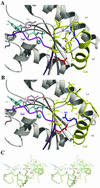The structural basis for the transition from Ras-GTP to Ras-GDP
- PMID: 12213964
- PMCID: PMC129411
- DOI: 10.1073/pnas.192453199
The structural basis for the transition from Ras-GTP to Ras-GDP
Abstract
The conformational changes in Ras that accompany the hydrolysis of GTP are critical to its function as a molecular switch in signaling pathways. Understanding how GTP is hydrolyzed by revealing the sequence of intermediary structures in the reaction is essential for understanding Ras signaling. Until now, no structure of an intermediate in GTP hydrolysis has been experimentally determined for Ras alone. We have solved the crystal structure of the Ala-59 to Gly mutant of Ras, (RasA59G), bound to guanosine 5'-imidotriphosphate or GDP to 1.7-A resolution. In the guanosine 5'-imidotriphosphate-bound form, this mutant adopts a conformation that is intermediate between the GTP- and GDP-bound forms of wild-type Ras and that is similar to what has been predicted by molecular dynamics simulation [Ma, J. P. & Karplus, M. (1997) Proc. Natl. Acad. Sci. USA 94, 11905-11910]. This conformation is stabilized by direct and water-mediated interactions between the switch 1 and switch 2 regions and is characterized by an increase in the binding affinity for GTP. We propose that the structural changes promoted by the Ala-59 to Gly mutation exhibit a discrete conformational state assumed by wild-type Ras during GTP hydrolysis.
Figures




References
-
- Barbacid M. (1987) Annu. Rev. Biochem. 56, 779-827. - PubMed
-
- Lowy D. R. & Willumsen, B. M. (1993) Annu. Rev. Biochem. 62, 851-891. - PubMed
-
- Vojtek A. B. & Der, C. J. (1998) J. Biol. Chem. 273, 19925-19928. - PubMed
-
- McCormick F. (1989) Cell 56, 5-8. - PubMed
-
- Bourne H. R., Sanders, D. A. & McCormick, F. (1990) Nature (London) 348, 125-132. - PubMed
Publication types
MeSH terms
Substances
Associated data
- Actions
- Actions
- Actions
Grants and funding
LinkOut - more resources
Full Text Sources
Other Literature Sources
Molecular Biology Databases

